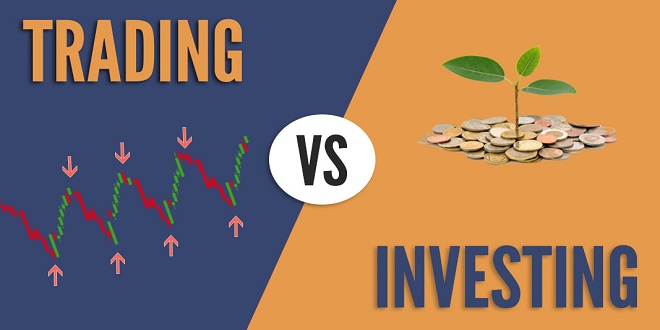The difference between investing and trading

There are two ways to make a profit on the financial markets: trading and investing. Investors and traders both seek to make money by participating in the markets. Investors are generally looking for higher returns by holding and purchasing over a longer time. However, traders take advantage of market movements (both rising and falling) to enter positions and then exit them within a shorter time frame, which leads to smaller and less frequent returns. Traders are more likely than investors to take short-term losses. Traders, however, are more likely to make transactions that enable them to profit from volatile markets.
Investing
You invest to slowly increase your wealth over a long period of time. This is done by purchasing and maintaining a variety of stocks, mutual funds, bonds, and stock baskets.
Investors have the option to increase their profits by compounding dividends and profits into stock shares.
Typically, investments are held for many years, if not decades. They also enjoy dividends, interest, and stock splits. Markets are subject to fluctuations, but investors can “ride out” downtrends by believing that prices will rise and losses will eventually be covered. Investors tend to be more concerned with the fundamentals of the market, such as the ratio of price to earnings or forecasts for management.
Everybody who invests in a 401(k), IRA or other investment vehicle has invested. This is regardless of whether they are keeping track of their investments on a regular basis. The plan is designed to grow over time and over years so fluctuations in the performance of mutual funds over the day are not as significant as continuous growth over a longer period.
Trading
Trading involves the sale and purchase of commodities, currencies, stock currency, currency pairs and other instruments. It is a way to achieve results that are better than buy-and-hold investment. Investors may be content with a yield of 1% to 15% each year, but traders might want to earn a 10% return every month. Trading profits are made by buying at a lower price and then selling at an even higher rate in the shortest time. The reverse is also possible: trading profits can be achieved by buying at a higher price, then selling at a lower rate (referred to as “selling short”) in order to make a profit in falling markets. RSI, which is the best trading signal, is great for individual stocks because it can help determine the stock’s price regularly.
Buy-and-hold investors wait to close out more lucrative opportunities. Traders are seeking to make profits in a short time. A protective order is also used to close any losing positions at a particular indication. Traders often use techniques such as moving averages and stochastic oscillators to analyze technical data in order to identify high-probability trading strategy.
The “style” of a trader is the time period or duration that commodities, stocks, or other trading instruments are bought and sold. Most traders fall into one of these four categories.
* Position Trader These positions can be held for up to.
* Swing Trader Positions are available from days to weeks.
“Day Trader”: Positions are maintained all day, but no overnight.
The positions will be held for a few seconds to minutes with no overnight position.
Conclusion
Long-term investing is a strategy that focuses on long-term markets. It is commonly used to fund retirement accounts and trade. Both require short-term strategies to increase returns on a daily basis, monthlyly or quarterly basis.


